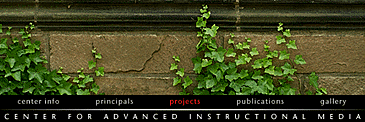Contents
Page Design
|
Introduction Graphic design 100 Balanced pages Design grids for pages Page headers Typography I Typography II Typefaces Consistency Basic Tables Page length Cross platform issues Editorial style Frames Advanced tables Style sheets Miscellaneous |
The best measure of home page efficiency
How many links are there in the top four inches of your menu page designs? The average computer display sold today is only about 14 to 16 inches in diagonal measurement, and shows a "desktop" of about 640 by 480 pixels. That should tell you that the top four inches of your Web home page is the most crucial area in your site
Think in screens of information, not pages
Always base your page header design on what the average reader with the average display monitor will see within the first screen of information. The most effective Web page headers incorporate a combination of graphics and interactive links, most often in the form of an imagemap. The imagemap banners at the top of the pages in the Yale C/AIM Web site are designed to deliver graphic impact to the page while offering the user six links within the top one and a half inches of the page:

Graphic has been reduced from the original size. www.med.yale.edu/caim/
Consistent graphic identity
One of the major purposes of careful graphic design is to provide a unique visual identity to your Web site. A consistent "signature" graphic and page layout allows the reader to immediately know what the main point of the document is, and what (if any) relationship the page may have to other pages. Graphics used within headers can also signal the relatedness of a series of Web pages. Unlike print documents, designers of Web systems can never be sure what (if any) other pages the reader has seen before linking to the current page. Sun Microsystem's many corporate Web sites all include a signature header graphic that is also an imagemap with basic navigation links included:
Graphic has been reduced from the original size. www.sun.com
Even if you choose not to use graphics on your pages, the header area of a Web page should contain a prominent title at or very near the top of the page. Graphics placed above the title line should not be so large that they force the title and introductory text off the page on standard office-size monitors (640x480 pixels). In a related series of documents there may also be subtitles, section titles, or other text elements that convey the relationship of the currently visible document to others in the series. To be effective, these title elements must be carefully standardized across all of the pages in your site.
Page footers
Page footers should always carry basic information about the origin and age of the page. Every Web page needs to bear this basic information, but this repetitive and prosaic information often does not deserve the prominence of being placed at the top of the page. Most Web pages are bigger than the average display screen, so that by the time most readers have scrolled to the bottom of the Web page the navigation links you might have provided at the top of the page are no longer visible. Well-designed page footers usually offer the user a set of links to other pages.
Graphic has been reduced from the original size. www.sun.com
References
Sun Microsystems Yale Center for Advanced Instructional Media (C/AIM) |